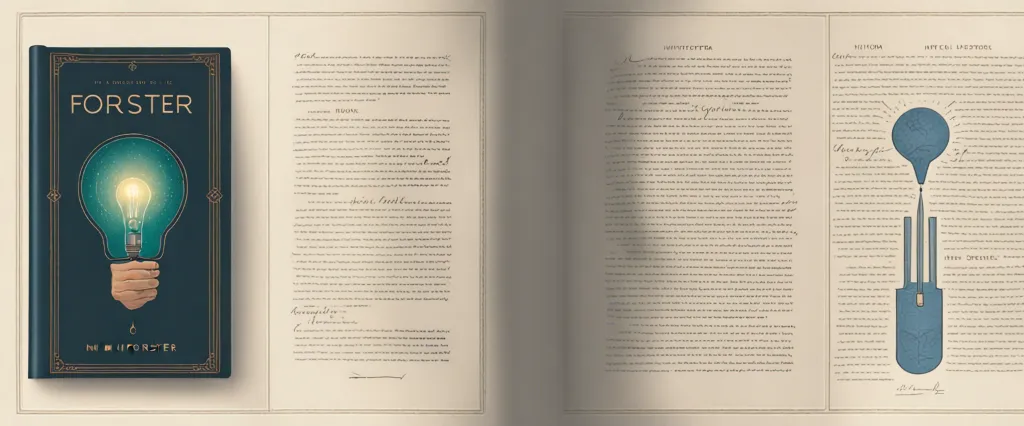In his renowned work “Aspects of the Novel,” E.M. Forster delves into the intricacies of storytelling and explores the fundamental elements that contribute to a compelling narrative. As a distinguished English novelist and essayist, Forster possessed a deep understanding of the literary craft, and his thoughts and insights continue to resonate with writers and readers alike. By unraveling the elusive nature of fiction, Forster invites us to embark on a journey through the various aspects that shape the novel and ultimately captivate our imagination.
Chapter 1: The Story in the Novel
Chapter 1 of the book “Aspects of the Novel” by E.M. Forster provides an introduction to the concept of storytelling in novels. Forster begins by explaining that novels, as a literary form, have a unique ability to capture and portray human experiences in a way that no other art form can. He describes novels as a collection of stories with individual narratives that make up the larger narrative of the novel as a whole.
The chapter further dives into the importance of the “story” within a novel. Forster highlights that the story is the backbone of any novel since it acts as the driving force that keeps readers engaged. He discusses various elements of a story, ranging from the plot and its structure to the characters and their development. Forster emphasizes the importance of conflict and tension in driving the story forward and keeping readers emotionally invested.
Furthermore, Forster touches upon the concept of a story’s rhythm and pace, illustrating how it affects the overall reading experience. He acknowledges that in some novels, the story moves quickly, while in others, it progresses slowly, allowing for deeper exploration of characters and themes.
Towards the end of the chapter, Forster explores the role of the narrator in telling the story. He explains the different types of narrators, including those who are reliable and adhere strictly to the truth, and those who are unreliable or limited in their perspective. Forster highlights that the choice of narrator can significantly shape the reader’s understanding and interpretation of the story.
Overall, Chapter 1 of “Aspects of the Novel” provides an insightful examination of the significance of storytelling in novels, touching upon key elements such as plot, conflict, character development, rhythm, pace, and the role of the narrator.
Chapter 2: The Characters in the Novel
Chapter 2 of E.M. Forster’s book “Aspects of the Novel” delves into the topic of characters in a novel and their significance to the reader. Forster begins by emphasizing that characters are the backbone of any story, as they provide a point of entry for the reader into the world of the novel.
He initially distinguishes between “flat characters” and “round characters.” Flat characters are those that are one-dimensional, possessing only a single dominant trait, while round characters are more complex, possessing multiple characteristics that make them be relatable and realistic.
Forster argues that the reader’s understanding of a character is deeply influenced by the author’s portrayal. He explains that characters should not simply be vehicles for the author to express their beliefs, but rather should possess independent existence in the story, with their own emotions, growth, and motivations. He emphasizes the importance of authors giving their characters autonomy, allowing them to surprise both the author and the reader.
Furthermore, Forster introduces the concept of “pattern” in character development. He argues that patterns can illuminate a character’s true qualities and motivations, making them resonate more deeply with the reader. These patterns can be reflected in their speech, actions, or even recurring physical characteristics.
The chapter concludes with Forster discussing the significance of character relationships in a novel. He asserts that characters need relationships with other characters to fully come to life: they gain depth and complexity through their interactions and reactions to others.
Overall, this chapter highlights the importance of characters in a novel, urging authors to create multi-dimensional, autonomous, and relatable characters, whose interactions and relationships add depth to the story.
Chapter 3: The Emotions in the Novel
Chapter 3 of E.M. Forster’s book “Aspects of the Novel” is titled “The Emotions in the Novel.” In this chapter, Forster explores the role of emotions in shaping the events and characters of a novel.
Forster begins by stating that emotions are essential as they enable the reader to connect with the characters and understand their motivations. He suggests that emotions should be depicted realistically, avoiding over-dramatization or excessive sentimentality. Instead of relying on clichés or stereotypes, authors should strive to capture the complexity and contradiction of human feelings in order to create a genuine emotional impact on the reader.
According to Forster, emotions are also necessary to drive the plot. Characters’ desires and emotions should propel the narrative forward, leading to conflict and resolution. He emphasizes the importance of establishing emotional connections between characters to create tension and advance the story.
Furthermore, Forster discusses the balance between showing and telling emotions. Although it is important to describe characters’ emotions explicitly through dialogue or narrative, he argues that allowing emotions to manifest through actions and physicality can create a more powerful impact. Through these actions, the reader can infer a character’s emotions and connect with their experiences.
To illustrate his points, Forster refers to specific examples from classic novels, including Leo Tolstoy’s “War and Peace” and Henry James’ “The Golden Bowl.” By examining these works, he highlights how emotions are portrayed and how they contribute to the overall success of the novel.
In conclusion, Chapter 3 of “Aspects of the Novel” highlights the significance of emotions in storytelling. Forster emphasizes the necessity of capturing genuine human feelings, using them to drive the plot, and striking a balance in their portrayal. Understanding and masterfully depicting emotions, according to Forster, is integral to creating an engaging novel that resonates with readers.
Chapter 4: The Imagination in the Novel

Chapter 4 of “Aspects of the Novel” by E.M. Forster, titled “The Imagination in the Novel,” explores the role and significance of imagination in storytelling. Forster begins by defining the two types of imagination found in novels: the mechanical and the imaginative. The mechanical imagination refers to a writer’s ability to create a compelling plot, while the imaginative imagination allows the writer to create vivid and believable characters.
Forster emphasizes that novels require both types of imagination to be successful. Without a well-structured plot, a novel can quickly become disorganized and lose the reader’s interest. On the other hand, without vivid and fully developed characters, a novel may lack depth and fail to resonate with the reader on a personal level.
The author goes on to discuss the importance of the reader’s imagination in engaging with the novel. He asserts that the novel is unique among art forms because it requires the reader’s active participation to imagine the world and characters within it. The reader’s imagination fills in the gaps left by the writer, and this collaboration between writer and reader is what makes the novel a truly immersive experience.
Forster argues that a novel’s success lies in its ability to strike a balance between providing enough detail to guide the reader’s imagination while also allowing room for interpretation. He suggests that the best novels are those that give the reader freedom to imagine, yet provide enough guidance to prevent confusion.
In conclusion, Chapter 4 of “Aspects of the Novel” explores the importance of imagination in storytelling. It highlights the necessity of both mechanical and imaginative imagination in crafting a successful novel, and emphasizes the collaborative nature of the reader-writer relationship in engaging with and interpreting the story.
Chapter 5: The Language in the Novel
Chapter 5: The Language in the Novel of E.M. Forster’s book Aspects of the Novel explores the importance of language as a tool for writers to create meaning and connect with readers. Forster emphasizes the need for clarity, precision, vitality, and economy in language.
The chapter begins by highlighting the role of language in character creation. Forster argues that language can reveal a character’s thoughts, emotions, and values, helping readers understand and empathize with them. By carefully choosing words and sentence structure, writers can effectively convey the subtle nuances of their characters’ personalities and motivations.
Furthermore, Forster discusses the significance of dialogue in the novel. He emphasizes the need for authentic dialogue that captures the unique speech patterns, idioms, and accents of each character. Dialogue, when written skillfully, not only develops characters but also advances the plot and enhances the overall narrative.
Forster also examines the role of imagery in the novel. He explains that imagery helps readers visualize and experience the story more vividly. By using descriptive language, writers can appeal to the readers’ senses and create a more immersive and engaging reading experience.
Another key point addressed in this chapter is the use of literary devices such as metaphors, similes, and irony. Forster asserts that these devices can add depth and complexity to the narrative, allowing writers to express abstract ideas and evoke an emotional response from the readers.
In conclusion, Chapter 5 of Aspects of the Novel emphasizes the power of language in constructing memorable characters, engaging dialogue, vivid imagery, and skillful use of literary devices. Forster’s insights serve as a guide for writers, highlighting the importance of language in creating a compelling and effective novel.
Chapter 6: The Structure of the Novel
In Chapter 6 of “Aspects of the Novel” by E.M. Forster, the author delves into the significance of the structure of a novel. Forster argues that the structure of a novel holds immense importance as it dictates the overall impact on readers and the success of the narrative.
Firstly, Forster highlights the role of plot in novel structure. He states that a good plot should be coherent and consistent, allowing readers to follow the story easily. However, he asserts that a plot should not be too predictable, as that would lead to boredom. Forster suggests that a balanced combination of structure and surprise is key to holding a reader’s interest.
Next, Forster examines the role of characters in the novel’s structure. He emphasizes the importance of creating believable and dynamic characters that contribute to the development of the plot. Characters should be consistent in their actions and motivations, and their interactions should be realistic and meaningful. Forster argues that characters are not simply puppets of the author but bring life and depth to the narrative.
Furthermore, Forster explores the significance of time and chronology in structuring a novel. He emphasizes that a well-planned timeline helps the reader understand the sequence of events and fosters a deeper connection with the story. However, Forster also acknowledges that rearranging the chronological order can add suspense and intrigue to the narrative, as long as it serves a purpose.
Lastly, Forster discusses the concept of pattern in structuring a novel. He asserts that a well-crafted pattern helps bring cohesion to the novel, giving the story a sense of unity and purpose. A pattern may arise from motifs, recurring themes, or the overall structure of the narrative itself.
Overall, Chapter 6 of “Aspects of the Novel” emphasizes the importance of a well-structured novel, highlighting the significance of plot, characters, time, and pattern in creating a compelling narrative that engages and resonates with readers.
Chapter 7: The Meaning of the Novel
In Chapter 7 of “Aspects of the Novel” by E.M. Forster, the author explores the essence and purpose of the novel as a literary form. Forster begins by establishing that novels are unique in their ability to delve into the complexities of human existence and offer insights into the meaning of life. He argues that while other artistic forms, such as poetry and painting, have their own merits, the novel has a distinct advantage: its ability to capture the vastness and diversity of human experience.
Forster points out that novels are often criticized for lacking a clear and didactic purpose, unlike other forms of literature. However, he argues that this perceived lack of purpose is actually a strength of the novel, as it allows for a deeper exploration of the complexities of life. Novels offer us a sustained and immersive experience through their characters, plots, and settings. They invite readers to engage with these narratives, allowing for a more profound understanding of the human condition.
The author also discusses the vitality of the novel in contemporary society, emphasizing that novels have the power to connect people across different cultures and time periods. He asserts that novels can transcend societal boundaries and provide a bridge between individuals, fostering empathy and understanding.
Forster concludes the chapter by noting that the meaning of a novel is not something fixed or predetermined, but rather a subjective experience that varies for each reader. He states that the interpretation of a novel depends on an individual’s subjective perception, personal experiences, and cultural background. The meaning of a novel, then, lies in the interaction between the writer’s intentions and the reader’s interpretation.
Overall, Chapter 7 of “Aspects of the Novel” highlights the unique role and significance of the novel as a form of literature. Forster presents the novel as a medium that allows for an exploration of human existence and meaning, while also acknowledging the subjective nature of the reading experience.

Chapter 8: The Value of the Novel
Chapter 8 of E.M. Forster’s book, “Aspects of the Novel,” explores the value that novels hold in society. Forster argues that the novel has a unique ability to capture the complexities of human experience and offer a deeper understanding of life.
According to Forster, novels have the power to delve into the psyche of characters, uncovering their innermost thoughts, emotions, and motivations. This exploration of individual consciousness allows readers to better understand the intricacies of human nature and the complexities of relationships. By presenting characters’ inner worlds, novels can provide valuable insights into the human condition.
Furthermore, Forster proposes that novels offer a space for empathy and connection. He argues that reading a novel is an intimate experience where readers can empathize with characters, forming a bond with them. In this way, novels have the potential to foster a sense of community, as readers develop a shared understanding and connection through literature.
Forster also emphasizes the unique role of novels in addressing societal issues. By examining the social, political, and cultural contexts within which they are written, novels have the power to critique and challenge prevailing ideologies and practices. Through presenting alternate perspectives and confronting societal norms, novels can be agents of change, encouraging readers to question and reconsider their own beliefs.
In conclusion, Forster asserts that novels are of profound value to individuals and societies. They offer a rich exploration of human experience and promote empathy, fostering connections among readers. Additionally, they have the potential to challenge and reshape society, bringing about social change. Ultimately, Forster argues that the novel’s ability to capture the complexities of life and its potential for societal impact make it an invaluable and enduring form of literature.
After Reading
In conclusion, E.M. Forster’s book “Aspects of the Novel” offers readers a comprehensive exploration of the key elements and techniques that shape and define the art form. Through his insightful analyses of plot, characters, narrative, and more, Forster emphasizes the importance of a novel’s ability to connect with human experience and capture the complexities of life. By examining various literary examples and drawing on his own experiences as a writer, Forster’s work serves as both an educational resource for aspiring authors and a thought-provoking analysis for all lovers of literature. Ultimately, “Aspects of the Novel” reminds us of the enduring power and significance of this versatile and ever-evolving art form.
1. “How Fiction Works” by James Wood – Similar to “Aspects of the Novel,” this book delves into the mechanics and intricacies of literature, exploring how different elements contribute to the overall effectiveness of a novel. James Wood, a renowned literary critic, examines a wide range of works and provides valuable insights into the craft of writing.
2. “The Art of Fiction” by John Gardner – This classic guide to writing fiction offers a comprehensive analysis of the elements that make a story successful. John Gardner explores various techniques, such as point of view, characterization, and plot, providing practical advice and illustrating his points with numerous examples. “The Art of Fiction” is a must-read for both aspiring writers and avid readers.
3. “Reading Like a Writer” by Francine Prose – In this book, Francine Prose emphasizes the significance of close reading and its impact on one’s writing skills. Drawing from a diverse selection of literature, Prose dissects the works and highlights the choices made by the authors, enabling readers to grasp the complexities of writing at a deeper level.
4. “The Complete Idiot’s Guide to Writing a Novel” by Tom Monteleone – This book is an excellent choice for beginners who are eager to embark on their writing journey. Tom Monteleone covers all the essential aspects of novel writing, from outlining and characterization to dialogue and pacing. With clear explanations and practical exercises, this guide provides a solid foundation for aspiring writers.
5. On Writing: A Memoir of the Craft” by Stephen King – Although Stephen King is primarily known for his fiction, he offers valuable insights into the writing process in this memoir-cum-guide. Combining personal anecdotes with practical advice, King explores various writing techniques and shares his own experiences and struggles as a writer. “On Writing” is a captivating and informative read for both King fans and anyone aspiring to become a novelist.




